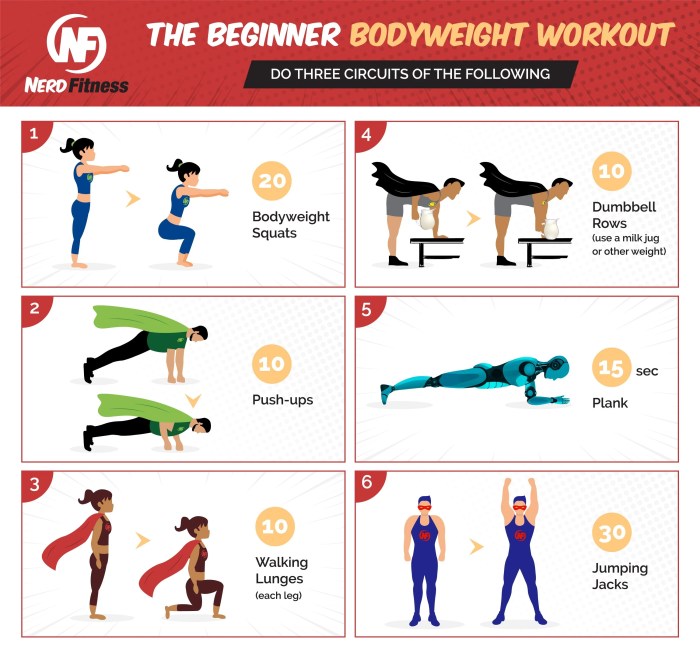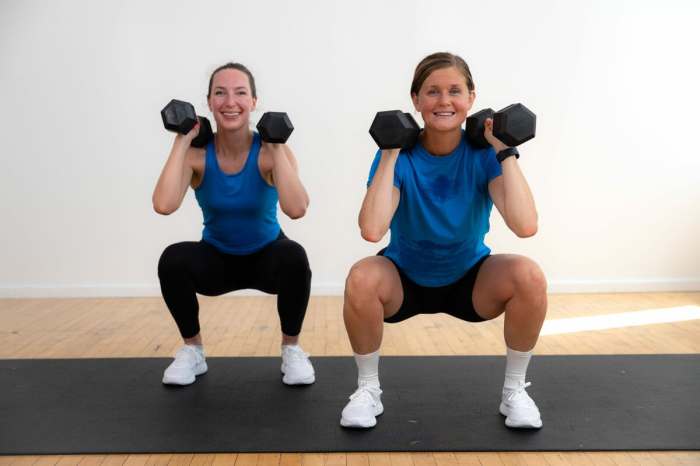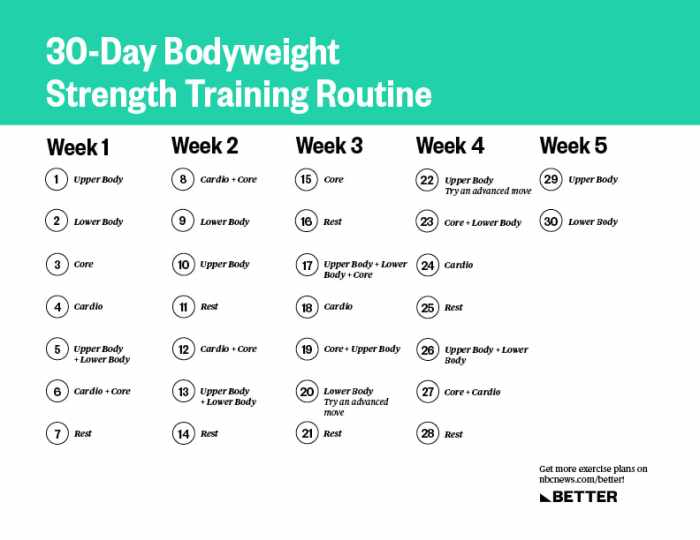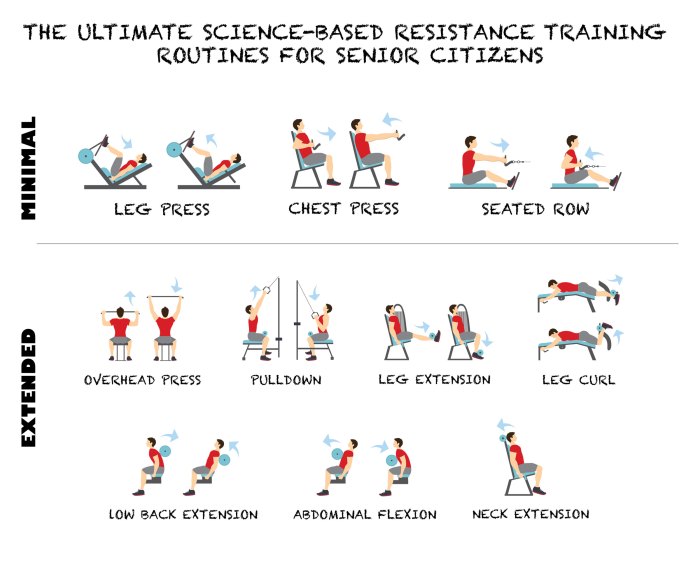Welcome to the ultimate guide to crafting the best strength workout program tailored to your unique needs and goals. In this comprehensive resource, we’ll delve into the fundamental principles of strength training, exploring the role of progressive overload, specificity, and rest in building a stronger, leaner physique.
From beginner to advanced lifters, this guide will empower you with the knowledge and tools to design a personalized program that maximizes your results. Whether you’re looking to enhance strength, build muscle, or improve overall fitness, we’ve got you covered.
Strength Training Principles: Best Strength Workout Program
Strength training is an essential component of any fitness routine. It helps build muscle, burn fat, and improve overall health. But to get the most out of your strength training workouts, it’s important to follow some basic principles.These principles include:
- Progressive overload: This means gradually increasing the weight or resistance you lift over time. This is what forces your muscles to adapt and grow stronger.
- Specificity: This means training your muscles for the specific activities you want to improve. For example, if you want to get better at running, you need to do exercises that work the muscles you use for running.
- Rest: This is just as important as training itself. When you rest, your muscles have a chance to recover and rebuild. Aim for at least 24 hours of rest between strength training workouts for each muscle group.
Program Design Considerations

Designing an effective strength training program involves considering various factors that influence your progress and safety. These include setting clear training goals, selecting appropriate exercises, and determining the optimal frequency, duration, and intensity of your workouts.
Training Goals
Define your specific strength training objectives, whether it’s building muscle, improving strength, or enhancing athletic performance. Your goals will guide the choice of exercises and the intensity of your workouts.
Exercise Selection
Choose exercises that target the muscle groups you aim to strengthen. Consider your fitness level, available equipment, and any limitations you may have. Compound exercises, which engage multiple muscle groups simultaneously, are efficient for maximizing results.
Frequency, Duration, and Intensity
Determine how often, for how long, and with what intensity you’ll train. These parameters depend on your fitness level, goals, and recovery capacity. Generally, beginners should start with 2-3 sessions per week, lasting 30-45 minutes each, at a moderate intensity.
Sample Beginner Program
Here’s a sample strength training program for beginners:
- Monday: Squats, lunges, push-ups
- Wednesday: Rest
- Friday: Rows, bicep curls, tricep extensions
- Repeat
Workout Structure
Workout structure refers to the way in which exercises are organized and grouped together within a training program. The three main types of workout structures are full-body, upper/lower body split, and push/pull/legs split.
The best workout structure for you will depend on your individual needs and goals. Consider your fitness level, experience, and time constraints when choosing a structure.
Full-Body Workouts
- Involve training all major muscle groups in a single workout session.
- Suitable for beginners or those with limited time.
- Can be less effective for advanced lifters seeking optimal muscle growth.
Upper/Lower Body Splits
- Divide workouts into two sessions: one for upper body and one for lower body.
- Allows for greater training volume and intensity for each muscle group.
- May require more time and gym visits per week.
Push/Pull/Legs Splits
- Group exercises based on movement patterns: pushing (e.g., bench press), pulling (e.g., rows), and leg exercises (e.g., squats).
- Allows for higher training frequency for each muscle group.
- May be more complex and require more advanced knowledge of exercise selection.
Warm-up and Cool-down

Warming up before strength training prepares your body for the strenuous activity. It increases body temperature, heart rate, and blood flow to the muscles, enhancing their flexibility and range of motion. Warming up reduces the risk of injuries and improves overall performance.
Cooling down after strength training helps your body recover. It gradually lowers your heart rate and blood pressure, promoting blood flow to the muscles and aiding in the removal of metabolic waste products. Cooling down reduces muscle soreness and stiffness, and promotes relaxation.
Warm-up Exercises
Dynamic stretching is an effective way to warm up before strength training. It involves controlled movements that mimic the exercises you’ll be performing during your workout.
- Arm circles
- Leg swings
- Jumping jacks
- High knees
- Butt kicks
Cool-down Exercises
Static stretching is recommended for cooling down after strength training. It involves holding each stretch for 15-30 seconds.
- Hamstring stretch
- Quadriceps stretch
- Calf stretch
- Chest stretch
- Triceps stretch
Nutrition for Strength Training
Nutrition plays a pivotal role in fueling your strength training endeavors. Consuming the right nutrients in adequate amounts is essential for building and repairing muscle tissue, providing energy for workouts, and optimizing recovery.
Importance of Macronutrients
Strength training requires a balanced intake of macronutrients:
Protein
Protein is the building block of muscle. Aim for 1.6-2.2 grams of protein per kilogram of body weight daily to support muscle growth and repair.
Carbohydrates
Carbohydrates provide energy for intense workouts. Consume whole grains, fruits, and vegetables to replenish glycogen stores.
Healthy Fats
Healthy fats support hormone production and cell function. Include avocados, nuts, and olive oil in your diet.
Meal Timing and Frequency
Pre-workout
Consume a meal or snack rich in carbohydrates and protein 1-2 hours before training to provide energy and support muscle protein synthesis.
Post-workout
Within 30-60 minutes after training, consume a meal or snack containing protein and carbohydrates to aid recovery and muscle growth.
Regular Meals and Snacks
Aim for 3-4 main meals and 1-2 snacks throughout the day to maintain stable blood sugar levels and support nutrient intake.
Nutrient-Rich Foods
Lean Protein
Chicken, fish, beans, lentils
Whole Grains
Brown rice, quinoa, oats
Fruits
Bananas, berries, apples
Vegetables
Spinach, broccoli, carrots
Healthy Fats
Avocado, olive oil, nuts
Supplements
Supplements can be beneficial in supporting strength training nutrition, but they should not replace a balanced diet. Consider:
Creatine
May enhance muscle power and recovery.
Protein Powders
Convenient way to increase protein intake.
BCAAs
Essential amino acids that support muscle growth and repair.
Recovery and Regeneration

Recovery and regeneration are crucial for muscle growth and strength development. They allow muscles to repair and rebuild, leading to increased strength and size.During exercise, muscle fibers are damaged, and the body needs time to repair and rebuild them. This process occurs during rest and recovery.
Sleep, hydration, and active recovery all play vital roles in this process.
Sleep
Sleep is essential for muscle recovery and growth. During sleep, the body releases hormones that promote muscle growth and repair. Aim for 7-9 hours of quality sleep each night.
Hydration, Best strength workout program
Hydration is vital for overall health and muscle recovery. Water helps transport nutrients to muscles and remove waste products. Drink plenty of water throughout the day, especially before and after workouts.
Active Recovery
Active recovery involves engaging in low-intensity activities that promote blood flow and muscle relaxation. Activities like walking, swimming, or yoga can help reduce muscle soreness and promote recovery.
Common Mistakes

Strength training beginners often make mistakes that can hinder their progress or even lead to injuries. Recognizing and avoiding these common pitfalls is crucial for optimizing training results.
Below are some of the most common mistakes made by beginners and how to avoid them:
Inadequate Warm-up and Cool-down
- Skipping warm-ups can lead to muscle strains and injuries.
- Proper warm-ups prepare the body for strenuous activity by increasing blood flow and body temperature.
- Cool-downs help reduce muscle soreness and promote recovery.
Incorrect Form
- Improper form can strain muscles, joints, and tendons.
- Focus on maintaining proper form throughout each exercise.
- Consult with a qualified trainer or fitness professional to ensure correct technique.
Overtraining
- Excessive training can lead to burnout, injuries, and decreased performance.
- Allow for adequate rest and recovery time between workouts.
- Listen to your body and take rest days when needed.
Ignoring Nutrition
- Proper nutrition is essential for muscle growth and recovery.
- Consume a balanced diet rich in protein, carbohydrates, and healthy fats.
- Hydrate well by drinking plenty of water before, during, and after workouts.
Insufficient Recovery
- Recovery is crucial for muscle growth and preventing injuries.
- Get enough sleep, as it promotes muscle repair and hormone production.
- Use active recovery methods like stretching, yoga, or light cardio to aid recovery.
Ego Lifting
- Lifting too much weight too soon can lead to injuries and plateaus.
- Start with a weight that allows you to maintain proper form.
- Gradually increase weight as you progress.
Lack of Consistency
- Inconsistent training can hinder progress and increase the risk of injuries.
- Establish a regular training schedule and stick to it as much as possible.
- Make strength training a priority and find ways to fit it into your routine.
Sample Strength Training Programs

Strength training programs can be tailored to specific fitness levels and goals. Here are sample programs for beginners, intermediates, and advanced individuals, with variations for strength building, muscle building, and fat loss.
Beginner Strength Training Program
Goal:Introduce strength training basics and build a foundation. Exercises:
- Squats
- Push-ups
- Rows
- Lunges
- Plank
Sets:3 Repetitions:10-12 Rest:60-90 seconds Frequency:2-3 times per week Sample Weekly Schedule:
Monday
Upper body (push-ups, rows)
Wednesday
Lower body (squats, lunges)
Friday
Core (plank)
Intermediate Strength Training Program
Goal:Increase strength and muscle mass. Exercises:
- Barbell squats
- Bench press
- Deadlifts
- Overhead press
- Pull-ups
Sets:3-4 Repetitions:8-12 Rest:90-120 seconds Frequency:3-4 times per week Sample Weekly Schedule:
Monday
Upper body (bench press, overhead press)
Tuesday
Lower body (barbell squats, deadlifts)
Thursday
Upper body (pull-ups, rows)
Saturday
Lower body (squats, lunges)
Advanced Strength Training Program
Goal:Enhance strength, power, and muscle size. Exercises:
- Heavy squats
- Weighted lunges
- Power cleans
- Snatch
- Bulgarian split squats
Sets:4-6 Repetitions:6-10 Rest:120-150 seconds Frequency:4-5 times per week Sample Weekly Schedule:
Monday
Upper body (bench press, overhead press)
Tuesday
Lower body (heavy squats, power cleans)
Wednesday
Rest
Thursday
Upper body (snatch, rows)
Friday
Lower body (weighted lunges, Bulgarian split squats)
Saturday
Rest
Sunday
Active recovery (light cardio, stretching)
Modifications for Different Equipment Availability
- If you don’t have access to a gym, use bodyweight exercises, resistance bands, or dumbbells.
- Adjust the weight or resistance based on your fitness level and goals.
- Focus on proper form and technique to prevent injuries.
Training Progression
In strength training, progress is essential to avoid plateaus and continue improving. Progression involves gradually increasing the demands placed on your body, such as weight, sets, repetitions, or intensity, over time. This forces your body to adapt and grow stronger.
Sample Progression Plan
Here’s a sample progression plan for increasing weight, sets, repetitions, and intensity:
- Week 1-4:Focus on building a solid foundation with lighter weights, higher repetitions (10-15), and 2-3 sets per exercise.
- Week 5-8:Gradually increase the weight by 5-10%, reduce the repetitions to 8-12, and maintain 3 sets per exercise.
- Week 9-12:Further increase the weight by 5-10%, lower the repetitions to 6-10, and add an additional set to each exercise.
- Week 13+:Continue increasing the weight as tolerated, gradually reducing the repetitions and increasing the sets. You can also incorporate intensity techniques like drop sets or supersets.
Importance of Rest and Recovery
Rest and recovery are crucial for progress in strength training. Your body needs time to repair and rebuild after intense workouts. Aim for 24-48 hours of rest between workouts for the same muscle groups. Additionally, schedule rest days throughout the week to allow for full-body recovery.
Listening to Your Body
Pay attention to your body’s signals and adjust your training accordingly. If you experience excessive fatigue, soreness, or pain, take rest days or reduce the intensity of your workouts. Pushing too hard without adequate rest can lead to injuries.
Periodization

Periodization is a training strategy that involves dividing your training program into different phases, each with a specific focus and goal. This helps to optimize your results by ensuring that you are training your body in a way that is most effective for your current fitness level and goals.
There are many different types of periodization, but the most common are linear periodization, undulating periodization, and block periodization.
Linear Periodization
Linear periodization is the simplest type of periodization. It involves gradually increasing the weight, volume, or intensity of your workouts over time. This type of periodization is best for beginners who are just starting out with strength training.
Undulating Periodization
Undulating periodization involves varying the weight, volume, or intensity of your workouts on a weekly or daily basis. This type of periodization is more challenging than linear periodization, but it can also be more effective for intermediate and advanced lifters.
Block Periodization
Block periodization involves dividing your training program into different blocks, each with a specific focus. For example, you might have a block of strength training, followed by a block of hypertrophy training, followed by a block of power training. This type of periodization is the most complex, but it can also be the most effective for advanced lifters.
| Type | Advantages | Disadvantages |
|---|---|---|
| Linear Periodization | Simple and easy to follow | Can be too monotonous |
| Undulating Periodization | More challenging than linear periodization | Can be more difficult to plan |
| Block Periodization | Most effective for advanced lifters | Most complex and difficult to plan |
Sample Periodization Plans
The following are sample periodization plans for beginner, intermediate, and advanced lifters.
Beginner Periodization Plan
* Week 1-4: Linear periodization with a focus on strength
Week 5-8
Undulating periodization with a focus on hypertrophy
Week 9-12
Linear periodization with a focus on power
Intermediate Periodization Plan
* Week 1-6: Block periodization with a focus on strength
Week 7-12
Block periodization with a focus on hypertrophy
Week 13-18
Block periodization with a focus on power
Advanced Periodization Plan
* Week 1-8: Block periodization with a focus on strength
Week 9-16
Block periodization with a focus on hypertrophy
Week 17-24
Block periodization with a focus on power
Closing Notes
As you embark on your strength training journey, remember to prioritize recovery, nutrition, and safety to optimize your progress. Stay motivated, adhere to your program, and enjoy the transformative benefits of strength training.
Unlock your fitness potential and achieve your strength goals with the ultimate guide to the best strength workout program. Let’s get started!
Commonly Asked Questions
What are the key principles of strength training?
Progressive overload, specificity, and rest are the cornerstones of effective strength training.
How often should I train?
The optimal training frequency depends on your fitness level and goals. Beginners may start with 2-3 sessions per week, while advanced lifters may train 4-6 times per week.
What is the best way to choose exercises?
Select exercises that target the muscle groups you want to develop, considering your fitness level and equipment availability.
How do I progress my workouts?
Gradually increase the weight, sets, repetitions, or intensity of your workouts over time to challenge your muscles and promote continuous progress.
Leave a Reply